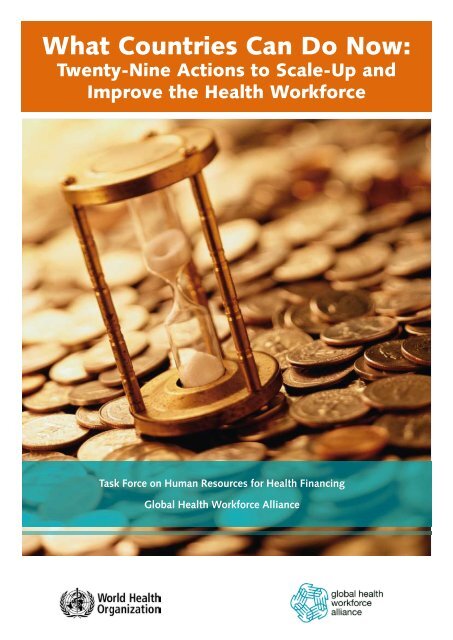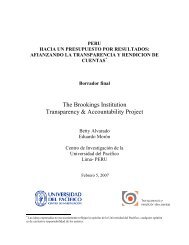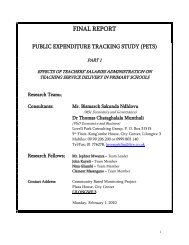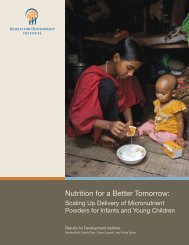What Countries Can Do Now: - World Health Organization
What Countries Can Do Now: - World Health Organization
What Countries Can Do Now: - World Health Organization
- No tags were found...
You also want an ePaper? Increase the reach of your titles
YUMPU automatically turns print PDFs into web optimized ePapers that Google loves.
<strong>What</strong> <strong>Countries</strong> <strong>Can</strong> <strong>Do</strong> <strong>Now</strong>:Twenty-Nine Actions to Scale-Up andImprove the <strong>Health</strong> WorkforceTask Force on Human Resources for <strong>Health</strong> FinancingGlobal <strong>Health</strong> Workforce Alliance
WHO Library Cataloguing-in-Publication DataFinancing and economic aspects of health workforce scale-up and improvement: framework paper: GHWAfinancing task force, October 2008.1.<strong>Health</strong> personnel - economics. 2.<strong>Health</strong> personnel - utilization. 3.<strong>Health</strong> manpower. 4.Developingcountries. I.<strong>World</strong> <strong>Health</strong> <strong>Organization</strong>.© <strong>World</strong> <strong>Health</strong> <strong>Organization</strong> (acting as the host organization for, and secretariat of, the Global <strong>Health</strong>Workforce Alliance), 2009All rights reserved. Publications of the <strong>World</strong> <strong>Health</strong> <strong>Organization</strong> can be obtained from WHO Press,<strong>World</strong> <strong>Health</strong> <strong>Organization</strong>, 20 Avenue Appia, 1211 Geneva 27, Switzerland (tel.: +41 22 791 3264;fax: +41 22 791 4857; e-mail: bookorders@who.int). Requests for permission to reproduce or translateWHO publications – whether for sale or for noncommercial distribution – should be addressed to WHOPress, at the above address (fax: +41 22 791 4806; e-mail: permissions@who.int).The designations employed and the presentation of the material in this publication do not imply theexpression of any opinion whatsoever on the part of the <strong>World</strong> <strong>Health</strong> <strong>Organization</strong> concerning the legalstatus of any country, territory, city or area or of its authorities, or concerning the delimitation of its frontiersor boundaries. <strong>Do</strong>tted lines on maps represent approximate border lines for which there may not yet be fullagreement.The mention of specific companies or of certain manufacturers’ products does not imply that they areendorsed or recommended by the <strong>World</strong> <strong>Health</strong> <strong>Organization</strong> in preference to others of a similar naturethat are not mentioned. Errors and omissions excepted, the names of proprietary products are distinguishedby initial capital letters.All reasonable precautions have been taken by the <strong>World</strong> <strong>Health</strong> <strong>Organization</strong> to verify the informationcontained in this publication. However, the published material is being distributed without warranty of anykind, either expressed or implied. The responsibility for the interpretation and use of the material lies withthe reader. In no event shall the <strong>World</strong> <strong>Health</strong> <strong>Organization</strong> be liable for damages arising from its use.Printed in ItalyLayout: www.paprika-annecy.comPicture on cover: © Danil Vachegin/fotolia
<strong>What</strong> <strong>Countries</strong> <strong>Can</strong> <strong>Do</strong> <strong>Now</strong>:Twenty-Nine Actions to Scale-Up andImprove the <strong>Health</strong> WorkforceTask Force on Human Resources for <strong>Health</strong> FinancingGlobal <strong>Health</strong> Workforce AllianceThis paper synthesizes the human resources for health financing work conducted to dateand sets out the topics requiring additional academic and field research. The analysis forthe paper was conducted by the Secretariat of the Financing Taskforce (FTF) under theguidance of FTF members.
ContentsIntroduction 1Issue One: How can countries pay for scaled upemployment of HRH? 2Issue Two: How can countries fund the investmentand recurrent costs of producing the needed HRH? 6Issue Three: <strong>What</strong> retention mechanisms have been tried,do they work, and how much do they cost? 10Issue Four: How much would it cost to achieve equitable employment? 12Issue Five: <strong>What</strong> efficiency measures for HRH performance work?How much do they cost? <strong>What</strong> are the gains in efficiencyand effectiveness and how do they affect the need for HRH? 14Issue Six:<strong>What</strong> are the key elements needed to strengthenHRH management and how much do they cost? 16Issue Seven: How do HRH in private employmentaffect the availability and use of health services? How canhealth financing policy affect the numbers, distribution,and performance of privately employed HRH tocontribute to national goals and objectives? 17
Introduction<strong>Health</strong> workers play a critical role in the provision of health care and represent thesingle largest cost element in providing health services in low-income countries.Many of the poorest countries in the world have been unable to meet the pressinghealth needs of their populations. Millions of people die prematurely, or sufferfrom illness or disability unnecessarily, because appropriate human resources forhealth (HRH) to provide care are not available to them.While the health workforce situation is complex and addressing it requires a longterm commitment from multiple stakeholders, there are actions that countriescould take immediately to alleviate the health conditions of their populations.This document explains seven financing and economic issues that matter forhealth workforce scale-up and financing. It then states twenty-nine actions thatpolicy-makers could take right away to address the issues, independent of anylong-term HRH interventions in progress.The seven issues are closely connected and interdependent. Some of them, suchas fiscal space and funding health workforce employment, are relevant to globalpolicymakers and development partners as well as country-level policy-makers.Others, such as in-service and pre-service training, deployment, efficiency, andresource management, are mainly for country-level policy-makers to tackle.The seven issues are based on an extensive review and synthesis of the literature,research findings, and experience to date on the financing and economic aspectsof the health workforce scale-up and improvement, conducted by the AllianceTask Force on Financing and documented in “Financing and economic aspectsof health workforce scale-up and improvement: Framework Paper.”1
Issue One: How can countries pay forscaled up employment of HRH?Why it mattersLow-income countries face resource constraints and difficult tradeoffs across andwithin sectors when attempting to meet the basic needs of their populations,including access to trained and effective human resources for health (HRH).<strong>Countries</strong> wishing to expand the number of HRH must mobilize resources topay the costs of: (1) HRH employment, including wages, benefits and incentives;(including in-service training/professional development) (2) HRH pre-servicetraining; and (3) HRH management.The long-term sustainability of HRH scale-up requires domestic resources to bemobilized, often supplemented by external resources. The availability of domesticresources depends on countries’ gross national income (GNI); government’sability to capture the GNI; the share of government revenue allocated to health;and the share of health spending allocated to HRH. Frequently, the availabledomestic resources are insufficient to meet the government’s plans for HRHscale-up. The recently renewed commitment by the international community toincrease aid to help countries meet the Millennium Development Goals (MDGs)should help fill the financing gap between the needed and available resources.While the willingness of the international community to provide aid offersopportunities for governments to accelerate their HRH programs’ scope andmeet the MDGs, countries also face challenges for macroeconomic management.These challenges include ensuring sustainability in the face of aid uncertaintyand variability and each country’s own long-term economic prospects.<strong>What</strong> countries can do1. Estimate the “fiscal space”/government funding that is likely to be availablefor employment of HRH through to the end date of countries’ HRH scaleupplans (e.g., 2015 if the plans are aligned with the MDGs). This involvesprojecting the funding that is likely to be available from government for HRHscale-up and would allow the Ministry of <strong>Health</strong> to compare the availableand required funding for covering HRH costs. The Ministry can vary theassumptions behind these funding projections and estimate “optimistic” and“pessimistic” scenarios for resources that could be available to meet HRHplans. The “gaps” calculated between plans for HRH scale-up and likelyfiscal space could be used in advocacy efforts within government and/or withexternal partners. Finally, based on the scenarios, the Ministry could re-assessits HRH plans to determine whether it is possible to adjust them while stillmeeting HRH needs, including achieving the MDGs and securing basic healthcare for all, but at lower cost, such as through additional measures to improvethe efficiency of HRH (See Box 1 and charts on pages 8 and 9).2 <strong>What</strong> <strong>Countries</strong> <strong>Can</strong> <strong>Do</strong> <strong>Now</strong>: Twenty-Nine Actions to Scale-Up and Improve the <strong>Health</strong> Workforce
2. The Ministry of <strong>Health</strong> can use the fiscal space analysis for advocacy. Thegap figures could be used to seek additional resources to make it possible toattain the planned HRH levels. These resources might come from governmentborrowing or from external support, or both. The Ministry of <strong>Health</strong> canwork with other health advocates, including in civil society and members ofparliament, to advocate for the necessary resources. Ministries and partnerscan also seek additional resources through global health initiatives such asthe Global Fund. Alternatively, if additional resources cannot be raised, thenthe Ministry can adjust its HRH scale-up plans in the short run to reflectonly those aspects that can be financed while working to secure adequateresources in the longer run. Other methods to close the gap might includeefforts to improve the efficiency of HRH (see area five below), or to reducethe need for government HRH by harnessing privately employed HRH (seearea seven below).3
Box 1: How to estimate countries’ fiscal spaceData requirementsThese fiscal space estimates would be based on the following variables:1. Economic growth2. Government capture of GNI3. Share of government revenue allocated to health4. Share of health spending allocated to HRHData sourcesThe Ministry of Finance and/or Economics could provide the predictedvalues for item one and the current values for items two and three. Itemfour should be available through examination of Ministry of <strong>Health</strong>budgets and expenditure reports. The National Budget would also havedata on items three and four.Data analysis/scenarios for resource gapsBased on the data variables above, Ministries can estimate “base”,“optimistic” and “pessimistic” scenarios.For examples, to estimate the “base” scenario, the Ministry cantake the data as given from the various sources. For “optimistic”levels of funding, the Ministry can make assumptions about: fastereconomic growth, greater government capture of GNI, higher share ofgovernment revenue allocated to health, and greater share of healthspending allocated to HRH to produce a maximum estimate of fiscalspace. Similarly, a “pessimistic” scenario could be developed.The comparison of the “base,” “optimistic,” and “pessimistic” scenariosof available resources could be compared against the costs of targeted/planned HRH employment. This comparison between the available andrequired resources would show the gap in necessary funding to meetcountries’ HRH scale up plans. The size of the gap, especially at the endof the planned period, is an indicator of the long-term sustainability ofthe HRH plans and needs for external support.It is recommended that countries not stop after making these initialcalculations, but rather that the calculations be updated at leastannually so that changes in circumstances (e.g., faster than expectedeconomic growth, lower than anticipated government capture of GNI)can be taken into account and implications for fiscal space for HRHemployment can be understood.4 <strong>What</strong> <strong>Countries</strong> <strong>Can</strong> <strong>Do</strong> <strong>Now</strong>: Twenty-Nine Actions to Scale-Up and Improve the <strong>Health</strong> Workforce
Example calculation of national fiscal space isshown below:Data CategoryAmountGNI 2008 (million) $5 000HRH employment cost in 2008 (million) $35.2HRH employment cost in 2013 (million) $84.6Expected GNI annual growth rate 4%Government capture of GNI 2008 15%Government capture of GNI 2013 16%Government allocation to health in 2008 10%Government allocation to health in 2013 14%Share of health spending to HRH 2008-2013 47%Projected fiscal space and cost of HRHemployment:90807060504030201002008 2009 2010 2011 2012 2013Cost of HRH EmplFiscal space5
Issue Two: How can countries fundthe investment and recurrent costsof producing the needed HRH?Why it mattersGiven the initial stock, attrition rates, and targets for scaling up the numbers andattaining an appropriate skill mix of HRH, a country’s medical education systemneeds to produce the desired HRH. 1There are recurrent costs to the pre-service training of HRH, in terms of payingteachers; providing books, labs and supplies, equipment, and maintenance offacilities and equipment; paying for living expenses of students; and so forth.In addition, there are investment costs that must be paid (or accounted for).When the scale-up of HRH requires enough additional students to be trainedthat additional physical capacity is needed, 2 then new buildings (classrooms,teachers’ offices, labs, etc.) must be paid for and built, whether as additionsto existing schools or as entirely new schools. Even when no new constructionis required, there is an investment cost to pre-service training in terms of theamortization of the existing schools used. The physical plant and equipment isdepreciating (losing financial value and physically deteriorating), such that it willneed replacement someday, even if not in the immediate financial planning timehorizon.The same fiscal constraints faced by governments concerning employment arerelevant for the costs of scaling up pre-service training. Governments are limitedby their tax take from GNI, by their willingness to borrow, and, in some cases, bythe availability and effectiveness of the in-country risk-pooling mechanisms togenerate financing from health service users. They must choose how to allocatetheir resources among competing sectors and among competing needs withinsectors. In practical terms, the allocation of government resources for pre-servicetraining of HRH is complicated by the fact that, in many countries, some or allpre-service HRH training is the responsibility of the ministry of education orhigher education, not the ministry of health, which is usually responsible foremployment of public sector HRH. This means that there must be coordinationbetween the ministries responsible for HRH pre-service training and employment,so that adequate and matched resources are allocated to both.<strong>What</strong> countries can do3. Begin dialogue with ministries of education and other relevant ministries.The estimated large cost of scaling up pre-service training (PST) means thatministries of education will be important partners for ministries of health andother ministries 3 in the effort to achieve HRH scale-up. Such partnerships are1 Alternatives are to send students to other countries for training or to recruit health workersfrom other countries, but most LICs are likely to train nearly all of their own HRH.2 Some countries, e.g., Sudan, have organized two shifts at schools to limit the need foradditional physical infrastructure.3 Some countries place “nurse training” in a specific ministerial department under vocationaleducation.6 <strong>What</strong> <strong>Countries</strong> <strong>Can</strong> <strong>Do</strong> <strong>Now</strong>: Twenty-Nine Actions to Scale-Up and Improve the <strong>Health</strong> Workforce
often not as easy as they might seem, so it is best to begin the discussionsaround them sooner rather than later.4. Find out how much the private sector could contribute. Many countries nowhave private HRH pre-service training schools, in addition to those operated bygovernments. The planning process should consider the graduates producedby these private schools and how many of them are likely to take governmentjobs. In addition, there might be ways to facilitate or stimulate investmentin additional private pre-service training capacity to alleviate public sectorcapacity limitations that otherwise could constrain HRH scale-up. For instance,governments could provide for streamlined approvals and accreditationprocesses, offer tax breaks, or provide scholarship support for student tuitionpayments. Governments could also enter into discussions and partnershipswith private schools to develop and implement strategies to ensure thatgraduates from these schools will contribute to meeting HRH needs in ruraland other underserved areas, such as by developing scholarship programsand recruitment strategies targeted at rural and socially disadvantagedpopulations, developing curricula that focus on rural primary health needs,and developing mentoring and service programs that enable students to learnabout and spend time in rural and other underserved areas. Also, governmentscould seek partnerships with private sector actors to encourage contributionsto investments in public institutions.5. Consider policies to require tuition contributions from students at governmentpre-service training schools to help pay for the costs of the training and theneeded expansion of capacity, while offering complementary student grantand loan programs to ensure access by all academically qualified applicants,regardless of family resources, to HRH training.6. Estimate and project the cost of HRH PST needed to meet HRH employmentobjectives as shown in Box 2 and the accompanying charts.7. Use projected costs for advocacy. Much as for employment costs, meetingHRH pre-service training needs will likely require significant new investmentsfrom governments and development partners. <strong>Health</strong> and educationministries, together with partners in civil society and parliament, can advocatefor the necessary resources internally and externally, as well as through theirinfluence on the use of global health initiative funding.8. Consider innovations and strategies that may make pre-service trainingmore cost effective. These include use of information and communicationtechnologies and targeted investments and strategies to reduce attritionfrom programs so that few resources are spent training students who donot graduate. The attrition-reduction strategies might include needs-basedfinancial aid, improved student housing, and academic support for studentswith inadequate secondary school backgrounds.9. Consider redesigning job roles and pre-service training methods to addresscountry’s specific needs. Redesign of jobs, to meet the specific needs ofthe country, and redesign of education and training, to meet the needsof the students, can greatly reduce both the cost and the length of HRHproduction.7
Box 2: How to estimate countries’ pre-service trainingcostsData requirements<strong>Countries</strong> would need to start collecting the data below from all of itstraining institutions for each of the medical cadres that the institutionstrain.PROJECTIONS FOR NUMBER OF GRADUATESi. How many graduates do PST institutions currently produce per year?ii. How many graduates are needed to meet HRH employmentobjectives?iii. How many graduates now enter government service, enter privateservice, emigrate, or choose not to practice?iv. How much of the gap between graduates needed to meetemployment objectives can be met by currently un-used pre-servicetraining capacity?COSTING INFORMATIONi. <strong>What</strong> are PST institutions recurrent costs (teacher salaries, utilities,labs, libraries)?ii. <strong>What</strong> assets and capital investments do PST institutions have?iii. How old are PST institutions? <strong>What</strong> is their expected life span?COSTING PROJECTIONSi. For recurrent costs:1. <strong>What</strong> do PST institutions plan to do that may cause them tochange their current cost structure?a. Plans to improve labs?b. Plans to adjust teacher to student ratios?c. Plans to provide more books, etc.?d. Plans to change the mix of national and expatriate teachers?e. Are dropout rates expected to change?ii. For capital investments:1. <strong>What</strong> capital outlays do PST institutions expect to have in thecoming several years?2. <strong>What</strong> is the expected life span of the capital investments?3. <strong>What</strong> is the replacement cost of these capital investments?REVENUESi. <strong>Do</strong> PST institutions collect any revenues from their students andothers? How much?1. Direct revenues:a. From student tuition payments and feesb. From donorsc. From the government: MOH, MOE, Other ministries (i.e.Capacity Building)2. In-kind contributionsa. Volunteer instructorsb. Private support for students’ living costs8 <strong>What</strong> <strong>Countries</strong> <strong>Can</strong> <strong>Do</strong> <strong>Now</strong>: Twenty-Nine Actions to Scale-Up and Improve the <strong>Health</strong> Workforce
Example estimate of country pre-serviceprojections:2008 2012 2015Graduates 50Enter private employment 10 16 22Emigrate or exit the sector 10 15 20Graduates need to meet HRH plans 30 50 80PST capacity in 2008 70Additional PST capacity needed 11 41AssumptionsAmountOperating costs per grad (000) $25Replacement capital per capacity (000) $13Investment cost per additional capacity (000) $200$ 9 000$ 8 000$ 7 000$ 6 000$ 5 000$ 4 000$ 3 000$ 2 000$ 1 000$-2008 2012 2015Operating costs Replacement capital New investment cost9
Issue Three: <strong>What</strong> retentionmechanisms have been tried, do theywork, and how much do they cost?Why it mattersWhen countries wish to scale up the numbers of HRH, they can do so throughsome combination of: (1) producing more HRH; and (2) decreasing attritionamong those already in place and of new entrants into the workforce. Theextent of attrition of HRH affects the needed numbers of new HRH and thusthe financing needed to produce them. Attrition is categorized as: economic andnatural.Economic attrition refers to a worker leaving the health sector to pursuealternative opportunities, for both financial (higher salary) and non-financial(better training or supervision, other working conditions; better housing; etc.)reasons. HRH sometimes find those opportunities in the health sector of anothercountry, or in other sectors in their own country. (From the point of view ofGovernments, a public sector employee moving to the private sector constitutesattrition.) Economic attrition could be reduced by improving the conditions inthe original sector, thus making the alternative comparatively less attractive. Ofcourse, financial and many non-financial incentives have costs.Natural attrition refers to workforce departures for reasons of retirement, death(especially in the face of HIV/AIDS), and so forth. To diminish natural attrition,countries can raise their retirement age, provide workers information aboutdisease prevention and ensure their own access to confidential, comprehensivehealth care, and improve workplace safety.Policy and financial choices can affect attrition and retention. Examples includepolicies concerning retirement age and requirements to serve in the governmentsector if one benefited from government-funded pre-service training. Theemployment opportunities, pay, benefits, and working conditions offered to HRHcan affect their choices to: (1) remain in or exit the health sector; (2) choose towork in government or private employment; (3) stay in or leave the country; and(4) serve in rural or other disadvantaged areas versus in cities or other relativelyprivileged areas.<strong>What</strong> countries can do10. Examine alternative financial and non-financial incentives and workingconditions that might reduce the temptation to emigrate. Ask HRH forfeedback (through surveys or focus group discussions) on the workingconditions and financial rewards that are important to them, to helpdetermine alternatives that are likely to work and to be affordable. Includeamong the possible alternatives bonding arrangements, where HRHthat have benefited from government subsidized pre-service training arerequired to serve in government employment for a given period of timepost graduation. Choose incentives and working conditions that indicatethe greatest payoff in terms of improved retention and quality of care forthe lowest cost. Note that many improvements in working conditions, such10 <strong>What</strong> <strong>Countries</strong> <strong>Can</strong> <strong>Do</strong> <strong>Now</strong>: Twenty-Nine Actions to Scale-Up and Improve the <strong>Health</strong> Workforce
as introduction of supportive supervision also are likely to have significantimpact on quality of care.11. Consider tailoring pre-service training of HRH to provide the skills neededfor the country’s specific situation, without necessarily providing the skillsthat facilitate emigration (as in Ethiopia’s CHW training and in China’s“chicken doctor” program).12. Consider changing policies for mandatory retirement ages or full pensionbenefits after a given number of years of service. Raising or eliminating amandatory retirement age could allow more HRH to remain in the workforce.Where full pension benefits have been promised after a given number ofyears of service, it might be considered unfair to take them away. However,not making this promise for new hires could help with retention in the future.For those to whom full pension benefits are promised, additional pensionbenefits might be offered if they agreed to stay at work longer.13. Find out from the country’s HRH diaspora what conditions might bring themback to the country. (Note that some countries’ physician diasporas, such asNigeria’s, have associations that can act as their representatives). Considerthe costs of the conditions against the likelihood of returned diaspora HRH(and what additional investment resources they might bring with them).14. Measure and monitor attrition rates by area. Areas to compare includegeographic (rural versus urban) and sector (public versus private). Thisinformation will help policymakers understand how current retentionstrategies are working and see where action is needed, for example, toimprove HRH working conditions in rural areas or increase remuneration ofHRH in the public sector to remain competitive with private providers.11
Issue Four: How much would it costto achieve equitable employment?Why it mattersMany countries have a physical distribution (or deployment) of HRH that wellserves those with relatively high incomes and poorly serves the disadvantaged,in contradiction to stated health priorities. This is the case for both governmentemployedHRH and those employed in the private sector.Governments face many challenges in deploying HRH to needy areas. It wouldseem that a government could deploy HRH wherever it wishes—to attack themajor sources of morbidity and mortality, this usually would mean putting HRHin rural areas and urban slums. Nonetheless, governments face practical issuesin trying to do so, such as: high attrition of HRH assigned to needy areas; theconstraints of civil service protections on disciplining HRH who do not reportto their assigned posts; and human resources information systems that are tooweak even to allow decision makers to know where HRH are deployed.Privately employed HRH are an important part of the overall HRH distribution.Private commercial providers respond to market demand in deciding where tolocate their services (including their HRH). They tend to locate their HRH wherethere is a concentration of income or where government provision is lacking innumbers or perceived quality. Urban populations tend to be better off financiallyand government-provided services are often considered to be of unsatisfactoryquality. Hence, there is a tendency for commercial private providers to locate inurban areas—though this is not to the total exclusion of poorer and more ruralareas in most countries. Household surveys often show that poor people devotehalf or more of their out-of-pocket spending on health to paying for privatelyprovided services. Commercial providers tend to look for underserved nichesand, sometimes, this can be serving the poor.Referral facilities and teaching hospitals are located in large population centers,thereby concentrating HRH. Thus, a “perfectly equal” deployment of HRH isunlikely to be achieved. However, a more equitable deployment than the statusquo in many countries is highly desirable, especially in the distribution of basicand primary care facilities and their HRH.<strong>What</strong> countries can do15. Recruit pre-service HRH likely to serve in under-resourced areas. Identifystudents using the following criteria in addition to academic qualification:(1) those with a positive attitude toward rural service and (2) those whocome from rural areas, so that once-trained, the new HRH will be more likelyto accept and remain in rural posts. Also, take other measures through theeducation system that could impact willingness of HRH to serve in underresourcedareas, including through curriculum reform to focus on ruralprimary health needs, and developing mentoring and service programs thatenable students to learn about and spend time in rural and other underservedareas.12 <strong>What</strong> <strong>Countries</strong> <strong>Can</strong> <strong>Do</strong> <strong>Now</strong>: Twenty-Nine Actions to Scale-Up and Improve the <strong>Health</strong> Workforce
16. Examine alternatives and then provide financial and non-financial incentivesto HRH posted to hardship areas, such as financial bonuses, provision ofhousing, access to children’s education, provision of water and electricity,security for female HRH, etc. A part of the process should be to ask HRH(again, through surveys or focus groups) what the most important incentivesare to them. Another part of the process could be to study what incentivesprivate providers, especially faith-based NGOs, offer to HRH in hardshipposts. Finally, it would be important to carefully monitor and evaluate thecost and degree of success of the incentives in attaining higher retention.13
Issue Five: <strong>What</strong> efficiency measuresfor HRH performance work? Howmuch do they cost? <strong>What</strong> are thegains in efficiency and effectivenessand how do they affect the need forHRH?Why it mattersEstimates of need for HRH implicitly make assumptions about HRH productivity—that is, how many people can be served effectively by each type of HRH. Ifproductivity can be increased, then the same health impact could be achievedwith fewer HRH. Clearly, it is in the interest of health systems to try to maximizeHRH productivity.To make a net gain in health financing, efforts to increase productivity mustproduce more value than the costs of the programs. When productivity increases,the financial gains for the systems stem from the need to employ and train fewerHRH to achieve a given target for service provision.Two methods to increase productivity are (1) management improvements; and(2) mechanisms to hold workers accountable for performance. Many governmenthealth systems give little attention to management of HRH. Thus, motivationand morale are often low and productivity suffers. Similarly, accountability forperformance within the government is weak. Civil service rules limit the abilityto offer incentives for good work or to sanction poor performance or the abuseof resources. There are few mechanisms to hold government HRH accountablefor the quantity or quality of their work or for the diversion of either work timeto private practice or drugs and supplies to sale for private benefit. The healthsector has seen an expanding number of experiences in using performancebasedapproaches to health financing in the early 21 st century. These effortshave focused on increasing the number of services provided and maintaining orimproving quality of care, but have given little attention to the specific effect ofperformance-based schemes on HRH.<strong>What</strong> countries can do17. Examine alternative methods to improve accountability of HRH, then chooseand apply the ones that look most promising given the country’s situation.These might involve performance-based management and contracting,decentralization, greater citizen oversight of performance, and setting upsystems where funding follows patients. Accountability systems also shouldconsider measures for discipline and sanction for poor performance.18. Ensure that HRH are provided with adequate support and tools to do theirjobs well. This would include providing supportive supervision and ensuringthat non-HRH inputs are available, such as drugs and consumable suppliesand working equipment.14 <strong>What</strong> <strong>Countries</strong> <strong>Can</strong> <strong>Do</strong> <strong>Now</strong>: Twenty-Nine Actions to Scale-Up and Improve the <strong>Health</strong> Workforce
19. Engage HRH trade unions and professional organizations (such as doctors,nurses, or midwives associations) to be partners in developing accountabilitymechanisms, since unilaterally implemented accountability systems are likelyto be considered “imposed” and provoke opposition.20. Conduct a task-shifting analysis to study whether the skills of HRH are wellmatchedwith the jobs that they are assigned. Where current assignmentsshow over-qualification, shift the tasks (with appropriate re-training whereneeded) to HRH with only the needed qualifications. This might entail anup-front expenditure for the re-training, but a savings over the longer termin employment costs.21. Draw lessons from experiences like Village Reach to find and eliminatewaste and inefficiency in the use of HRH in the supply chain for healthinputs. This might mean out-sourcing some functions, such as transport ofinputs or provision of services such as food and laundry to hospitals.15
Issue Six: <strong>What</strong> are the keyelements needed to strengthen HRHmanagement and how much do theycost?Why it mattersThe efficiency and effectiveness of HRH are affected by the quality of humanresources management. Traditionally, ministries of health have given littleattention to and allocated few resources for HRH management. In somecountries, HRH are not managed by ministries of health, but rather by overallministries of civil service. Hence, even the minimal functions of managing HRHworkforce numbers, skills, and deployment are done poorly, if at all. The bestministries of health focus on even more comprehensive “human resourcesdevelopment” that includes planning and formulation of human resourcespolicy; education, training and skills development; managing the migration ofskilled health personnel; and advocacy.The Capacity Project identifies the following challenges for HRH managementby governments in low-income countries: (1) inaccurate or incomplete dataabout the health workforce; (2) inadequate numbers of qualified health workers;(3) mismatches between needed and available health worker skills; (4) retentionproblems; (5) slow and ineffective recruitment, hiring, and deployment processes;(6) lack of supportive policies; (7) weak planning and management systems; and(8) poor use of available financial and material resources.<strong>What</strong> countries can do22. Budget for and then upgrade the staffing of HRH departments in Ministriesof <strong>Health</strong> and build or develop HRH information management systems.23. Obtain guidance about the essential functions of a strong HRH managementsystem and implement them. The USAID-funded Capacity Project is onegood source for this kind of guidance, another is the University of WesternCape Free Courseware Project.24. Involve HRH managers in strategic decision-making processes of Ministriesof <strong>Health</strong>, including analysis of the HRH implications of all strategic choices.Examples include scale-up of (1) anti-retroviral treatment, likely to drawon scarce skilled HRH, or (2) malaria prevention programs, such as ITNdistribution and IRS, that might reduce demand for curative care.25. Work with schools of business administration and private providers of healthservices to develop modules on HRH management to add to curricula for HRmanagement, so that both government and private health service providerscan employ graduates with knowledge of and skills for HRH management.16 <strong>What</strong> <strong>Countries</strong> <strong>Can</strong> <strong>Do</strong> <strong>Now</strong>: Twenty-Nine Actions to Scale-Up and Improve the <strong>Health</strong> Workforce
Issue Seven: How do HRH in privateemployment affect the availabilityand use of health services? Howcan health financing policy affectthe numbers, distribution, andperformance of privately employedHRH to contribute to national goalsand objectives?Why it mattersIn much of the developing world, the private sector is the most important sourceof medicine and medical care, and yet planners at ministries of health frequentlygive little attention to privately provided services. Private sector actors can becategorized as: for-profit companies, nonprofit organizations, social enterprises,insurers, providers, and drug and other health equipment manufacturers. Theseprivate sector actors account for as much as 50 percent of health care provisionin sub-Saharan Africa (Conway et al., 2007). Estimating the exact share of HRHworking in the private sector is difficult due to “moonlighting.” 4 There are noglobal estimates and the numbers vary by country, from as little as 20 percentto as much as 70 percent. 5 Private commercial providers of health services areconcentrated in urban areas, and their HRH are similarly concentrated. In manycountries, nonprofit private providers seek to serve the underserved, so theirHRH likely are found mainly in rural areas and urban slums.Thus, few governments have a comprehensive picture of the numbers anddistribution of privately employed HRH, despite their importance in deliveringservices.In addition to working parallel to government in offering health services, privateproviders are competitors with government for the employment of HRH. Someof the economic attrition of government HRH is to domestic private employment.Private employers have more flexibility than government in offering wages,working conditions, and benefits to HRH. Government employment often hasadvantages over private employment in the form of greater job security, theoffer of pension benefits, and, sometimes, access to more and better equipment.“Moonlighters” try to obtain the advantages of working for both governmentand private employers. Government retention strategies could benefit fromexamining what is offered by private employers both to stem attrition to thoseemployers and to learn how private employers seek to reduce their attritionlosses to emigration.4 Moonlighting refers to the practice of public sector HRH working in the private sector inparallel with their public sector appointments.5 These estimates have different approaches to estimating the number of HRH in theprivate sector: in some cases, the HRH cited work only in the private sector while in othercases, they work in both sectors.17
<strong>What</strong> countries can do26. Monitor employment data concerning the private sector, includingthe numbers of HRH employed, geographic distribution, productivity,compensation, the services they offer, and the populations they serve. Thesekinds of data would provide a comprehensive picture of the overall HRHsituation, allow the monitoring of trends, and provide useful information todevise policy initiatives to influence the direction of private HRH activities.27. Use data on private employment of HRH in making decisions concerningscale-up of pre-service training (see Area Two above).28. Study and learn from private providers concerning what they do to: (1)retain HRH in the face of incentives to emigrate and (2) successfully postHRH to hardship geographic areas.29. Specifically, consider assisting in or stimulating the development of privateinitiatives in the following areas:a. Pre-service training of HRH (e.g., creation or expansion of private medical,nursing, midwife, and other schools).b. Private payment of tuition fees for pre-service training (complemented bygovernment-sponsored student grant and loan programs to ensure accessfor all qualified students).c. Provision of health services under performance-based contract, where theprivate contractor hires, manages, and ensures the working conditionsneeded for appropriate HRH.18 <strong>What</strong> <strong>Countries</strong> <strong>Can</strong> <strong>Do</strong> <strong>Now</strong>: Twenty-Nine Actions to Scale-Up and Improve the <strong>Health</strong> Workforce
The Global <strong>Health</strong> Workforce Alliance<strong>World</strong> <strong>Health</strong> <strong>Organization</strong>Avenue Appia 201121 Geneva 27SwitzerlandTel: + 41.22.791.1046Fax: + 41.22.791.4841E-mail: ghwa@who.intwww.who.int/workforcealliance<strong>Health</strong> workers for all and all for health workers
















